THE 3 BEST SHOULDER EXERCISES FOR MASS
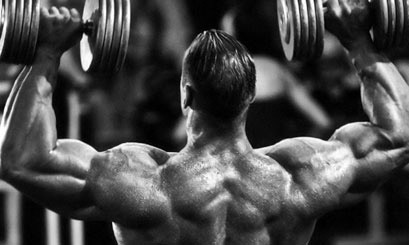
Should you prioritize shoulder exercises for mass to the upper body?
The answer is: absolutely. If you’re looking to build an impressive, muscular body, properly developed shoulders are an absolute must.
Full, thick deltoids will cause your upper body to appear wider and thicker (especially in clothes) and will help to create that v-tapered look that all bodybuilders strive for.
Proper exercise selection is the cornerstone of any effective shoulder workout.
Choose the wrong exercises (or execute them incorrectly) and you’ll end up shifting the stress off of the deltoid muscle and onto surrounding muscles such as the chest, traps, and upper back. Not only that, but your chances of injury will increase as well.
In this article I’m going to outline the absolute best shoulder exercises for mass and give you some quick tips to maximize their effectiveness.
Let’s first go over some very basic anatomy…
Basic Shoulder Anatomy
The shoulder contains 3 separate heads that perform the function of lifting and rotating the arm: the anterior head (the front), the medial head (the side), and the posterior head (the rear).
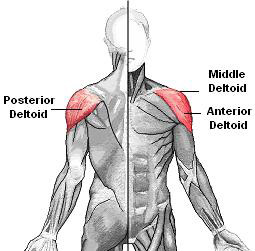
For maximum development, all 3 heads need to be properly stimulated.
This is accomplished using 2 different movements: overhead presses and raises.
Overhead presses stimulate the anterior and medial head, while raises isolate each individual head depending on how they’re performed. (Front raises isolate the anterior head, side lateral raises isolate the medial head, and rear lateral raises isolate the posterior head.)
For optimal shoulder development there are 3 main exercises that you should place your focus on…
The 3 Best Shoulder Exercises For Mass
#1 – Seated Overhead Dumbbell Press
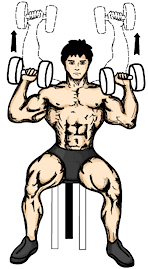
This movement should be the bread and butter of your shoulder routine.
Many lifters use the military press as their core movement (an overhead press using a barbell), but the dumbbell press is superior for a few very important reasons…
Firstly, the military press shifts most of the focus onto the anterior head with minimal involvement of the medial head. This is because military presses lock your arms out in front of your body. With the dumbbell press, the movement begins with your arms out to the side, which allows you to involve both the anterior and the medial head.
Secondly, dumbbell presses allow your arms to move through a more natural range of motion. The barbell locks your arms into a fixed movement pattern which increases your chances for rotator cuff injury.
Third, dumbbells allow each arm to move independently. This allows for balanced development of each shoulder since one arm can’t cheat for the other.
Here are 3 key tips to get the most out of your seated overhead dumbbell presses…
Tip #1: When you press the dumbbells up, stop just short of locking out your elbows. This keeps the tension on the shoulder throughout the entire movement and reduces the chance of injury.
Tip #2: Make sure to lower the dumbbells all the way back down to shoulder level. A lot of lifters end up performing partial reps by only bringing the weights down until their upper arms are parallel to the floor. Performing only the top half of the rep reduces shoulder involvement and uses mostly triceps.
Tip #3: Keep your lower back relatively straight. When you place a large arch in your lower back you end up shifting the tension onto your chest while minimizing shoulder involvement.
#2- Side Lateral Raises
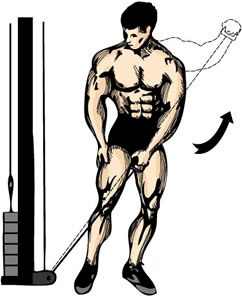
Side lateral raises are a very important exercise because they’re the only movement that allows you to directly isolate the medial head of the shoulder with minimal involvement of the anterior and posterior head.
You can either perform your side lateral raises using dumbbells (both arms at the same time) or a cable (one arm at a time).
If I had to choose one, I’d recommend going with standing cable side laterals. This is because cable side laterals keep the tension on the deltoid throughout the entire movement, whereas at the bottom of a dumbbell side lateral there is almost no tension on the shoulder at all.
A few tips for maximizing the effectiveness of your side lateral raises…
Tip #1: Stick to slightly lighter weights and higher reps for all side lateral movements. Going too heavy puts a lot of stress on the shoulder joint, which is an area very susceptible to injury. In addition, using excessive weight brings other muscles into play (such as the traps and spinal erectors) and reduces the tension on the medial deltoid. Utilize a rep range of 8-10, going as high as 12 if you prefer.
Tip #2: In order to minimize the involvement of the anterior head, focus on leaning slightly forward, keeping your shoulders down and back and pulling the weights up using your elbow and pinky finger rather than your hand.
Tip #3: Keep your abs tight and flexed throughout the entire movement to take the spinal erectors out of the equation and shift even more stress onto the medial head of the shoulder.
Tip #4: Only raise the weights up until your upper arms are parallel to the floor. Going any higher simply recruits the traps and provides no additional stress on the shoulders.
#3 – Bent Over Rear Lateral Raises
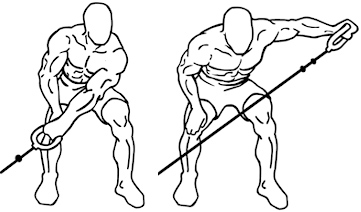
Rear lateral raises isolate the posterior head of the shoulder to round out your overall shoulder development. They’re also one of the best rear delt exercises.
Because the posterior head is heavily stimulated during all rowing movements for your back, rear lateral raises are not an absolute must for everyone. That said, most lifters tend to have an imbalance between their anterior/posterior deltoids due to an over-emphasis on pressing movements. For that reason they’re probably a good idea to include for most people.
As with side lateral raises, your rear lateral raises can be performed using dumbbells or a cable. Again, because the dumbbell variation provides no resistance in the bottom position, cables are probably a better choice.
In order to make sure that you maximize the tension on the posterior deltoid without involving other muscle groups (such as the traps, mid-back and lats) make sure to:
Tip #1: Focus on pulling with your elbow rather than your hand.
Tip #2: Allow your shoulders to relax and hang slightly forward throughout the entire exercise. If you allow your scapula to retract (even slightly) it shifts the tension away from the shoulder and onto the muscles of the back.
Tip #3: Stay away from heavy weight/low rep sets and stick to a rep range of 8-10 (going as high as 12) for the best results.
What about front raises?
Though a very common exercise you’ll see being performed in the gym, there’s actually no real reason to bother isolating the anterior head of the shoulder using front raises.
The anterior head is heavily stimulated on all of your basic pressing movements for chest and shoulders, and for that reason it doesn’t require any additional work. Over-developing the anterior head is actually dangerous because it causes the shoulder blade to roll forward, increasing the chance of rotator cuff injuries. [See related about reducing shoulder pain while bench pressing].
Best Shoulder Exercises For Mass: Wrapping It Up
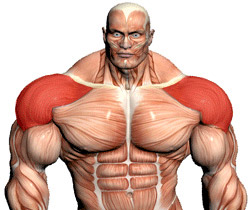
For complete and well-rounded shoulder development all you really need is a basic seated overhead dumbbell press, side lateral raise (dumbbell or cable) and bent over rear lateral raise (dumbbell or cable).
And just as important as it is to choose the right exercises, it’s equally important to make sure that you utilize proper form at all times. Although the movements themselves are fairly straightforward, any small errors can easily take the stress off of your shoulder and place it onto surrounding muscles.
Make sure to follow the tips outlined in this article to ensure that you’re getting the greatest shoulder stimulation possible while keeping your joints healthy in the process.
If you found this article helpful, make sure to sign up for your FREE custom fitness plan below...




